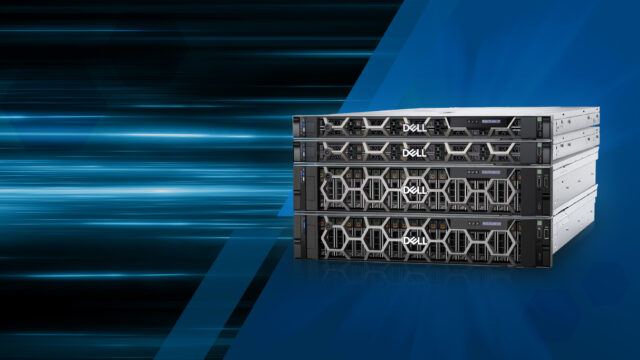Enterprise computing is essential to the success of many of our customers’ businesses. Pushing the limits of innovation with agility and performance, all with an eye on sustainability is key when competing in today’s environment. For more sustainable performance that takes up less space in the data center, look no further than the latest generation of Dell PowerEdge servers powered by 4th Generation AMD EPYC™ processors.
We understand the unrelenting need for server performance to power the business outcomes needed for today’s fast-paced business. Yet most customers will tell you that incremental data center real estate is increasingly hard to find. Every day, IT professionals face a myriad of unprecedented IT challenges like this and trust Dell Technologies to provide expert guidance and solutions.
Our customers are expected to implement the latest technology to keep their businesses competitive, safeguard their data from hackers, and critically, discover ways to use less energy. This all needs to be done while looking for faster ways to automate routine updates and attract qualified help from a shrinking pool of talent. These challenges require a holistic set of solutions that include the latest in hardware technology.
To help address those challenges, today we are introducing the latest generation of Dell PowerEdge servers powered by 4th Generation AMD EPYC™ processors, the Dell PowerEdge R7625, R7615, R6625 and R6615.
These servers showcase world-record performance along with a new set of features that dynamically scale to accommodate even the most demanding applications, driving a faster return on investment by optimizing clock speed and frequency to complete more workloads faster. Bolstering these next-generation servers are PowerEdge’s unwavering anchor tenants of cyber resiliency, automation, sustainability, secure supply chain and global services.
Accelerating Performance
These Dell systems tout the highest cores per processor – 50 percent more than the previous generation of AMD EPYC CPUs – and the best overall performance we’ve tested to date. Furthermore, they include only 40% increase in thermal design power (TDP). While increasing TDP, we are also boosting CPU efficiency with the new DPU-PCIe (SmartNIC) that connects x8 lanes to CPU1 and x8 lanes to CPU2. These new features add up to more performance while generating less heat in your data center.
The systems also include a new class of DDR5 memory that will reach up to 4800MT/s, and improved RAS features with on-die ECC along with the latest PCIe Gen5 capability that doubles throughput from PCIe Gen4. State-of-the-art storage improvements, using EDSFF-E3, are roughly half the physical size of a 2.5-inch SSD, maximizing density while reducing the amount of heat they produce. This means you can process and save more data in a smaller footprint while saving space for future growth in your data center.
In addition, we’ve recorded world-record performance for a variety of workloads like AI, databases and Java applications using the following benchmarks.
-
- Multiple AI performance world records on (TPCx-AI)1 driving faster insights with up to 425 AI use cases processed per minute from a single node.
- 107% more database users with a world-record score.2
- World-record SPECjbb performance highlighting Java application performance. 3
And to do more for less, the features below help consolidate your server base and save valuable investment dollars, delivering the performance you desire with fewer systems, and helping to preserve the environment by consuming less power per unit, reducing your carbon footprint.
-
- Testing showed over 121% higher performance with just a 40% increase in TDP going to 4th Gen AMD EPYC processors top bin from 3rd Gen AMD EPYC processors top bin maximizing performance in a single server. 4
- Improved efficiency with 55% greater CPU performance/watt helps you attain your sustainability goals by using less power and lowering your energy bill. 5
- 4th Generation AMD EPYC processors’ 96-core system has 50% more cores in a single system to support consolidation into fewer servers, saving power and cooling costs while achieving maximum performance. 6
- Increased storage limits with up to 60% more drives in a 2U server and 33% more drives in a 1U server enabling more workloads like dense virtualization, VDI and HCI to run on fewer servers. 7
Accelerating Workloads
Taking a closer look at how each system can help move your business forward, you’ll find that each is uniquely designed and balanced to address a primary set of workloads.
The 2U dual socket R7625 is the most powerful and expandable system of the group. Capable of delivering the highest application performance due to its expandability using an air-cooled chassis. It is ideal for data analytics to drive faster and more strategically guided decisions to improve business performance.
The 2U single-socket R7615 design provides expansion capability to use full-height cards in a single-socket server maximizing one-socket performance with plentiful expandability for storage or other peripherals like networking and greater memory per core. It is well-positioned to support more virtualization instances which drive economies of scale and greater efficiency.
The 1U dual socket R6625 has identical processing power as the R7625 in a 1U chassis and requires half the space in a rack. It’s also lighter and easier for employees to change out of physical nodes found in large clusters and is ideal for high-performance computing to solve the most complex science or engineering problems faster.
And lastly, the 1U single-socket R6615 is well suited to support network functions virtualization (NFV). This is done by virtualizing and thereby eliminating the need for multiple network hardware appliances by using an OpenStack Ready Architecture applicable for Telco applications. It also has an excellent price for a performance solution, providing two socket power with only one socket.
As expected, these four new systems provide the power, scale and configurability to support key workloads faster, cooler and more efficiently than ever before. With new hardware features and capabilities, PowerEdge delivers a complete solution that is well-positioned to successfully move your business forward. To learn more, please visit our PowerEdge Servers Powered by AMD site.
1 Based on Dell analysis of submitted TPCx-AI scores for scale factor 3, 10, 30, 100 and 300 as of 11/10/2022. Actual performance might vary.
2 Based on Dell analysis of submitted 1-S SAP-SD score of 75780 Benchmark users achieved on a Dell PowerEdge R7615 with an AMD Epyc 9654 processor compared to the previous best score of 36600 achieved on a Dell PowerEdge R7515 with an AMD Epyc 7763 processor. Actual results will vary.
3 Based on the top score submitted by Dell for the distributed SPECjbb Max-JOPS benchmark to SPEC.org to be published by 11/10/2022. Actual results will vary.
4 Based on Dell analysis of submitted SPECFPRate score of 1410 achieved on a Dell PowerEdge R7625 with AMD Epyc 9654s (cTDP 400W) compared to the previous high score of 636 on a Dell PowerEdge R7525 with AMD Epyc 7763 (cTDP 280W) processors as of 11/3/2022. Actual performance will vary.
5 Based on Dell internal calculations using SPECFPRate score of 1410 achieved on a Dell PowerEdge R7625 and a processor cTDP of 400W with AMD Epyc 9654s compared to a score of 636 and cTDP of 280W on a Dell PowerEdge R7525 with AMD Epyc 7763 processors. Actual performance will vary.
6 Based on a comparison of Dell PowerEdge Servers with AMD Epyc 4th gen of processors with a maximum of 96 cores per Socket and the Dell PowerEdge servers with AMD Epyc 3rd gen of processors with a max of 64 cores per socket.
7 Based on Dell internal analysis of available front drive slots going from a maximum of 24 drives in prior generation configurations to 32 E3.S drives config option in the latest gen 2U platforms and 10 to 16 drives for 1U platforms. Available storage will depend on configuration and drives chosen.



